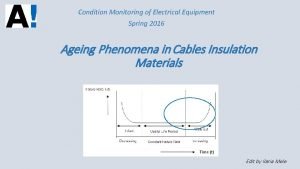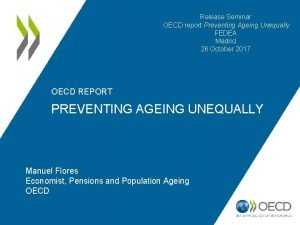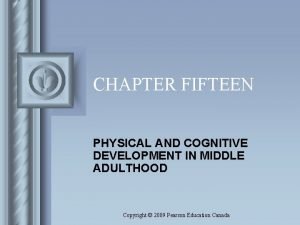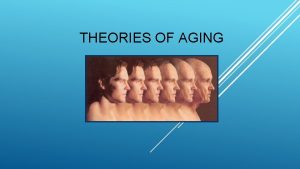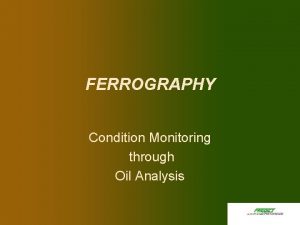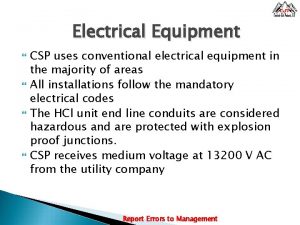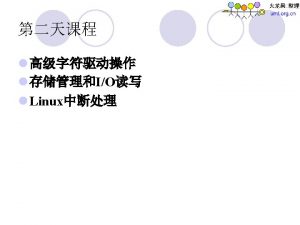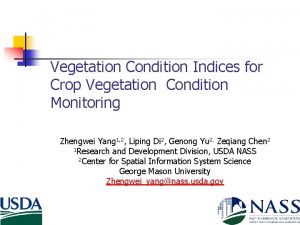Condition Monitoring of Electrical Equipment Spring 2016 Ageing










- Slides: 10

Condition Monitoring of Electrical Equipment Spring 2016 Ageing Phenomena in Cables Insulation Materials Edit by Ilaria Mele

‘’Ageing’’ is the accumulation of the normal changes of the material. It leads to a performances decreas and increasing of the failure rate. It is influenced by : • Enviromental effects: animals, UV light, dirt • Operative effects: overvoltages, vibration • Constructive imperfections: voids, inhomogeneity. • TWO PRINCIPALS INSULATIONS MATERIALS 1. PAPER AND OIL INSULATION The oldest insulation system, it belong to the organic insulation group. Easy and cheap to use, with good dielectric proprieties. THREE TYPES OF STRESS 2. POLYMER INSULATION ENVIROMENTAL STRESS Used since the 1960, the final use depends by the manufacturing process. This categorie concerns the Thermoplastic and Thermoset plastic. MECHANICAL STRESS ELECTRICAL STRESS

Ageing index: Weight reduction Oxidation Decrease of Maximum Temperature reduction Performance Temperature is one of the most studied type of stress. It is, and also, an important parameter that affects the other ageing process. The chemical reactions are accelerated by the temperature, Arrenhius equation shows the connection between temperature and chemical reaction acceleration. It is valid only if a single reaction is happening. life expectancy [h] 2∙ 10 104 • ΔE : activation energy of the reaction • T : temperature (K) • k : Boltzman costant • AR : material costant 103 Through the Arrhenius formula is possible to obtain the plot that relates the temperature and expectancy of life. 102 10120 TI HIC 0. 25 14 00. 24 160 0. 23 180 0. 22 temperature 200 220 T [°C] -1 0. 21 ∙ 10 -2 1/T [K ]

1. Paper and oil insulation degradation The properties of oil and paper will change during their lifetime. Cables are affected by difference type of stress at the same time. Oil reacts with of oxygen, leading to the productions of free radicals. Hydrocarbon molecules in oil oxidize into Hydrogen peroxide that rapidly disintegrates into free radicals. A free radical is an atom that contains an impared electron. They are enstable and reactive.

Moisture Hydrolysis and Oxidation It works in long period, and has dangerous effects only if the protective lead sheat is mechanically damaged. After the moisture penetration (it needs months) the process is characterized by: Hydrolytic degradation is caused by water and acids. The result is a reduction in the degree of polymerisation and weakening of paper mechanical properties. Oxidation takes place when oxygen attacks the carbon atoms in the cellulose molecule. Water, acids and carbon monoxide are produced. Bonds between cellulose are weakened. Step Time Current Weeks 10 m. A Sporadic arc Days 100 m. A Intermittent Arc Days Continuos arc Days water concentration in paper [%] Low level of partial discharge water in oil [mg/kg] It leads to a failure

Thermal degradation or Pyrolisis Is the most serius phenomena for paper insulated cables Can take place without access of oxygen or moisture. During normal operation when the temperature is below 140 °C, pyrolysis processes are considered insignificant. Electrical Stress Overvoltages: any voltage level above the rated voltage In addition, over voltages are dangerous for the insulation material. Some of them are momentary, whereas others are sustained. Partial discharge: is local accumulation of electric field. PD is a symptom of insulation weakness DUE TO: • Small mechanical damage of insulation • Voids in the insulation due to manufacturing faults. Once the void’s withstand voltage is exceeded, partial discharge occurs. Overloading: It leads to transient overcurrents and continous overcurrents. Inappropriate heat transfer: it affects soil thermal resistivity and increase the heat transfer of the cable. Over heating: it can breakdown polymers and deforms the insulation layers. Increase the rate of PD in the insulation. Increases dielectric losses Cause erosion and can eventually lead to breakdown. Reduction of electrical withstand strength. This produces a rapid rate of change of current Positive ions and electrons released by the discharge collide with the void wall causing slow erosion.

Furthermore… Different kinds of gases can be produced during the degradation of cables. Gases such as carbon monoxide, carbon dioxide and smaller amounts of hydrogen, methane and ethane are produced. These gases can displace the oil and fill the areas between paper strips. The electric field strength inside a gas cavity is higher than in the surrounding insulation. When the withstand level of the cavity is exceeded partial discharge will occur. Partial discharge can produce new gas filled cavities and conductive particles. The withstand level of oil is reduced because carbon particles tend to dissolve init. Oil-paper insulation is partly self healing with respect to partial discharge phenomena. In some cases partial discharges and gas filled cavities can disappear because the oil can move and replace the gas in cavities. Mechanical stresses can also promote the inception of partial discharges Degradation of paper mainly affects its mechanical properties. During degradation the degree of polymerization of the insulating paper is decreased. The degree of polymerization of new paper is around 1100 to 1500 while a value less than 500 indicates significant thermal degradation. Weakening of mechanical properties can lead to cable failure during short circuits. DP DP, Degree of Polymerization defines the condition of paper insulation. An high value of DP means high melting temperature and mechanical strength relative lifetime

2. Polymer insulation Thermoset (Irreversibly cured ) Thermoplastic (Can be re-melted and remolded) Their main proprieties are the mechanical and dielectric strentgh, both are influnced by the temperature. Mechanical stress: It is due to the presence of voids , techinical imperfection or inhomogeneous insulation distribution. These features can cause, in the future, internal mechanical stress. Chemical degradation: It is caused by free radicals formed during the oxidation. Their presence depends by the percentage of oxigen, the temperature, and the amount of radiation. Chemical degradation, is also, connected with the PD (Partial Discharge), because it augments the formation of free radicals. Electric degradation : Locally or randomly distributed it does not affect the whole length of the cable. Partial discharge, Electric trees, Water trees Partial discharge is a local accumulation of electric field, can lead to erosion and breakdown of the polymeric chains. It can be schematized in 3 steps: Gradual erosion and homogeneous deterioration of the cavity wall. Discharge concentrates on a specific region of the cavity forming deeper recesses in the wall. Conductive channels form and develop in a branching pattern , until complete breakdown occurs.

Electric trees An electrical tree is a network of thin conductive channels that propagate relatively quickly through the insulation to cause failure. It can start from an eroded surface of voids or in micro cavieties. The tree growth rate depends on the applied electrical stress, the temperature, the environmental and mechanical stresses. The size of the tree is, in the initil phase about 0, 1 -0, 2 p. C but when it reaches 5 p. C it can leadto thermal runaway. Total breakdown of the insulation can happen when the branch of an electrical tree bridges the electrodes, sometimes it can occur before this moment. Water trees The majority of XLPE insulated cables installed in the ground are exposed tomoisture, and as a result are susceptible to degradation due to water trees. This phenomenon develops mostly in insulation exposed to an alternating electric field and humidity. Impurities inside the insulation material will increase the risk of water tree initiation. The water trees starts in microscopic inhomogeneities of the insulation, andstart to propagate in the direction of the electric field in a bush ortree form. Bow-tie water trees: It reaches a limiting length of some tens of μm, and do not have a significant effect on degradation at the low electric field stresses. Vented water trees: It needs a longer initiation time and can cause more severe degradation than bow tie water trees The difference between a electric and a water treeare: • Water tree, does not necessarily form a permanent and visible track in the insulation Electric trees are usually visible. • When electric field and moisture are removed, water trees disappears. • Formation of the water trees will take years. • Water trees are formed at lower electric field strengths than electricaltrees. • Water trees can evolve in electric trees.

Thermal degradation: Insulation temperature should be below 90° C , in fault condition the temperature reaches 120°C. The free radicals composition happens between 150 and 225 °C, and they cause crosslinking, reduction of thechain strength. At 350°C there is thermal craking, and coke formation. Thermal degradation affects the cable for the whole length. Water trees Electric trees Bow tie Vented Partial Discharge Thermal degradation
